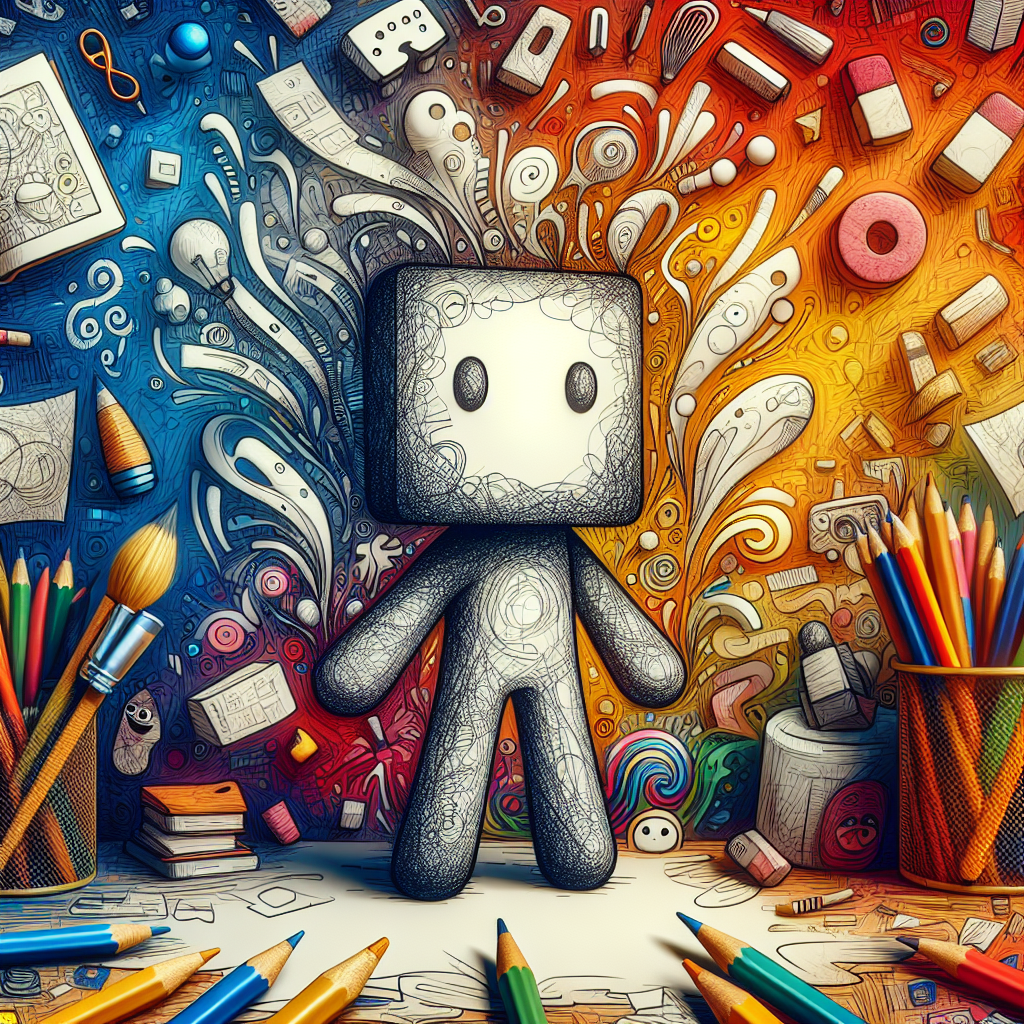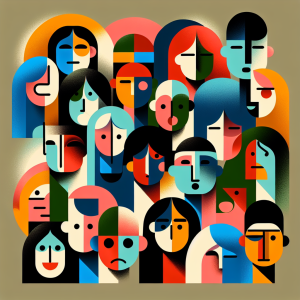Imagine a world where emotions are transmitted not through the curves of a smile or the furrow of a brow, but through the sheer essence of shape, color, and movement. Welcome to the intriguing realm of faceless cartoon art—a style that transcends traditional character design. Here, artists embrace simplicity, crafting characters that speak volumes without featuring the complexity of facial expressions. It’s a delightful paradox that opens the door to creativity, expression, and connection. In this article, we will explore the enchanting world of faceless cartoon art, unravel its concepts, techniques, and the unique charm it offers.
The Evolution of Cartoon Art
Cartoon art has come a long way from the early days of hand-drawn animation and comic strips. Traditionally, characters were vividly expressive, full of quirks and identifiable traits. However, as art evolves, so does the need for innovative storytelling methods. Faceless cartoon art emerged as a refreshing alternative, focusing not on facial features but on design, movement, and context. It’s this evolution that invites artists and audiences alike to engage with characters on a new level.
The Appeal of Faceless Characters
So, why do we find faceless characters captivating? There are a multitude of reasons:
- Universal Relatability: Without distinct facial features, characters become blank canvases, allowing viewers to project their emotions and experiences onto them.
- Focus on Action: Movement and body language take center stage. Each gesture enhances the narrative, inviting a different kind of emotional engagement.
- Simplicity is Striking: The minimalist design reduces visual noise, making characters memorable and iconic. Think of how easily you can recognize characters like the famous ‘stick figure’ or the whimsical creatures of animation.
Crafting a Faceless Character
Creating a faceless character may sound easy, but it comes down to harnessing the principles of design and narrative effectively. Here’s a guide to help you get started:
1. Choose a Design Style
Faceless characters come in various styles—simple shapes, abstract designs, or exaggerated forms. Decide on a style that resonates with you and the story you want to tell. For instance, a round, soft figure may elicit feelings of warmth and kindness, while sharper shapes could convey edginess or intrigue.
2. Focus on Body Language
Without facial expressions, body language becomes an essential tool for conveying emotion. Consider the way you position the limbs and posture. A slumped posture may indicate sadness, while legs in a springing posture can communicate excitement or joy. Pay attention to how these nuances change the character’s perceived personality.
3. Use Color Wisely
Color speaks volumes in art. A vibrant palette can evoke happiness, while muted tones might suggest calmness or melancholy. Experiment with colors that enhance your character and align with their narrative—whether it’s a cozy, earth-toned character resonating with comfort, or a bright and bold character representing adventure.
4. Create Context
Surround your faceless character with objects or settings that hint at their personality and background. Whether it’s a companion pet, items they frequently use, or the environment they inhabit, context provides depth, making your character relatable and intriguing.
The Role of Storytelling
Every character has a tale waiting to unfold. In faceless art, storytelling often involves more than words—it’s about crafting a relationship between the character and the audience. Here are some storytelling techniques suited for faceless art:
1. Use Movement
Movement tells its own story. An animated faceless character can portray a journey through jumps, spins, or simple walking motions. Consider creating a short sequential art piece showing your character in various dynamic actions to narrate their adventure.
2. Incorporate Symbolism
Using symbols effectively can add layers to your character’s portrayal. Perhaps your character always carries an umbrella, hinting at their thoughtful nature or readiness for any situation. Small details allow the audience to connect the dots, enhancing their engagement with the character.
3. Engage with Emotions
Even without features, you can communicate feelings through the overall composition. Use spacing, color saturation, and juxtaposition with others in the scene to manipulate the emotional response from your audience. Consider how a character might relate to their environment—are they lost in a bustling city or comfortably settled in a peaceful meadow?
Exploring Faceless Art Across Mediums
Faceless cartoon art is not confined to a single format; it thrives across various mediums. Let’s take a quick tour of how this art form manifests in animation, comics, and digital art:
1. Animation
In the world of animation, faceless characters can engage audiences through movement and sound. Animated shorts featuring simple, faceless designs often emphasize storytelling and nuance over visual complexity, creating a relatable character through their actions and surroundings. Look at shows like “Adventure Time”—characters with minimal features still convey their emotions wonderfully through a mix of design and storytelling.
2. Comics and Graphic Novels
Faceless characters in comics can serve as vessels for humor, satire, and commentary. A clever gag or poignant story can often depend upon the readers’ interpretations of the character without any facial distraction. Many indie comic artists embrace faceless characters, leveraging simplicity to resonate deeply with their audience.
3. Digital Art & Illustration
The digital landscape encourages artists to experiment with faceless designs. With endless tools and options at their fingertips, artists can create stunning visuals that evoke strong emotions while keeping things abstract. Online platforms have nurtured communities where artists share faceless creations, gathering inspiration and feedback that fuels further creativity.
Tips for Artists: Embracing the Craft
If you’re thrilled about diving into faceless cartoon art, here are some handy tips to get your creative juices flowing:
1. Practice Minimalism
Start practicing minimalism in your designs. Strip back your character to essential shapes and forms. The goal is to keep it simple while conveying profound ideas or emotions. Engaging with minimalist art challenges your existing perspective, building your skills.
2. Experiment with Different Styles
Don’t limit yourself to one approach. Try varying styles—different color palettes, shapes, or forms. Embrace the blend of abstract and practical as you uncover your unique artistic voice.
3. Join an Art Community
Find your tribe! Engaging with fellow artists, whether in online forums or local groups, provides invaluable support and feedback. Sharing your faceless creations sparks discussion and inspires growth as an artist.
4. Keep a Sketchbook
Your sketchbook is your playground. Dedicate time to explore different ideas without the pressure of perfection. Allow your imagination free rein, sketch relentlessly, and let your faceless characters evolve organically.
5. Analyze Other Work
Study the work of others who excel in faceless art. What are their techniques? How do they convey emotion? Critically analyzing art helps you broaden insights into your creations, enriching your own style.
Emotional Impact of Faceless Art
It’s fascinating how faceless characters can stir emotions deeply. By representing a blank slate, they invite viewers to find personal meanings. Imagine a character in despair—their silhouette might stand isolated against a vibrant background. This contrast highlights their struggle, evoking empathy without a single facial expression.
Moreover, faceless art often cultivates a sense of mystery. The lack of defined features sparks curiosity—what’s behind this character? Why are they feeling this way? This interplay between simplicity and intrigue leads audiences to explore narratives with their imagination, cultivating a more engaging experience.
The Cultural Impact of Faceless Cartoon Art
Faceless cartoon art has found a significant niche in various cultures, amplifying its reach. Artists worldwide adopt this style to convey messages about identity, anonymity, and the human experience. For instance, it can represent broader societal issues like mental health, where a faceless body can symbolize the struggle faced by many who feel invisible in their challenges.
Moreover, faceless art fosters inclusivity; it underscores the idea that while each person has a unique story, we all share the common tapestry of life. This resonance reflects a collective connection rather than individuality, echoing themes prevalent in popular culture across different regions.
The Future of Faceless Cartoon Art
As we look to the horizon, faceless cartoon art continues to grow in popularity and relevance. With the rise of social media, artists have more opportunities to showcase their work to a global audience. Platforms like Instagram and TikTok provide an arena where creators can experiment with the visual and narrative possibilities of faceless designs, reaching a broader audience than ever before.
Moreover, educational platforms are increasingly embracing this art form, offering tutorials, courses, and content aimed at teaching budding artists the craft of faceless character design. This increased accessibility inspires a new generation to explore creativity without the confines of detailed realism, broadening the artistic landscape.
Conclusion: Embrace the Abstract!
Faceless cartoon art presents an extraordinary invitation to artists and audiences alike. It challenges us to rethink how we interpret characters and stories while offering a whimsical escape into creative simplicity. By focusing on body language, color, and context, we can create profound narratives that resonate on a universal level.
So, grab your sketchbook, let your imagination run wild, and embrace the enticing world of faceless character creation. In a world brimming with visual chaos, there’s something refreshingly profound about characters who exist without features, reminding us that sometimes, simplicity breeds the most eloquent storytelling.
FAQs
What is faceless cartoon art?
Faceless cartoon art is a style that focuses on characters without distinct facial features, using shapes, colors, and body language to convey emotions and narratives instead. This minimalist approach allows for greater relatability and interpretation from the audience.
Why do artists choose to create faceless characters?
Artists create faceless characters to allow viewers to project their emotions onto the character, making the experience more universal. It emphasizes the character’s actions and context over facial expressions, which can lead to a different kind of emotional engagement.
Can you use faceless art in animation?
Absolutely! Faceless characters can be very effective in animation. Through movement and timing, animators can convey personality, emotion, and storytelling without the need for facial features. Many animated shows and shorts successfully utilize this technique.
How do I get started with faceless cartoon art?
Start by practicing minimal designs, focusing on body language and color. Experiment with different styles and analyze other artists’ work for inspiration. Keep a sketchbook to explore concepts and ideas freely.
What impact does faceless art have on viewers?
Faceless art invites viewers to engage their imagination, allowing them to interpret characters’ emotions and narratives personally. This can lead to a deeper emotional connection and greater understanding of the themes presented within the artwork.








+ There are no comments
Add yours